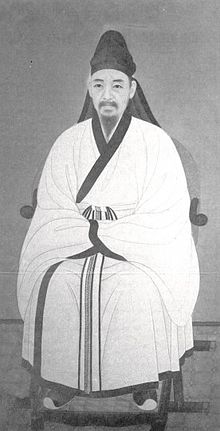Monggeumpo Taryeong
| Monggeumpo Taryeong | |
| Hangul | 몽금포타령 |
|---|---|
| Hanja | 夢金浦打令 |
| Revised Romanization | Monggeumpotaryeong |
| McCune–Reischauer | Monggŭmp'ot'aryŏng |
| IPA | moŋ.ɡɯːm.pʰo.tʰaːrjŋ |
"Monggeumpo Taryeong" (Korean: 몽금포타령; Hanja: 夢金浦打令; IPA pronunciation: moŋ.ɡɯːm.pʰo.tʰaːrjŋ) is a representative[1] Korean folk song (minyo [a]) of the northwestern areas of the Hwanghae and Pyeongan provinces of North Korea.[3][4] The song describes the lives of local fishermen and the surrounding port, village, hills, and scenery.[4][5] The song is about lovers in a beautiful harbor who wait and sing for the return of their loved ones, who are sailors.[4]
The harbor in the song is Monggeumpo Harbor in Jangyeon-gun (administrative division), near the Jangsangot mountain range in Hwanghae Province.[2][5] It is sung in a nasal tone to connote sorrow and melancholy.[4] The song was composed by Kim In-sook (김인숙; 金仁淑; Kim Insuk), and first became popular in the late Joseon dynasty due to social change.[6] The song follows the Jungmori Jangdan beat (중모리장단),[4][6] which is also used in pansori and sanjo.[7] The song can also be played in the slower Gutgeori Jangdan beat, which also fits its rhythm and tone.[6] An alternative name for the song is "Jangsangot Taryeong" (장산곶타령; 長山串打令).[8]
History
"Monggeumpo Taryeong" originated in the Hwanghae and Pyeongan regions of Korea. The song's musical features can be traced to the local folk song "Anju Aewongok" (Korean: 안주애원곡) from the Pyeongan region. "Monggeumpo Taryeong" first became more widely popular in the late Joseon dynasty due to social change, and became a part of city entertainment culture.[6] The song's verses were first confirmed in the Joseon Japgajip, (조선잡가집; 朝鮮雜歌集; Chosŏnjapkajip), which the publishing house Shinguseorim (신구서림; 新舊書林; Shin'gusŏrim) published in 1918.[6][9] "Monggeumpo Taryeong" is the subject of Kim Seong-tae's (김성태; Kim Sŏngt'ae) 1944 Capriccio for Symphonic Orchestra.[8] In the early 21st century, the song is used as musical curriculum in textbooks used in South Korean schools,[10] and is sung as an arranged choral song.[8] Gugak (national songs) such as "Monggeumpo Taryeong", however, may be removed from textbooks in the future.[10] Modern singers sing "Monggeumpo Taryeong" due to its popularity.[11][unreliable source?]
Composition
"Monggeumpo Taryeong" is unique because it differs from the rhythm and beat of other folk songs of the Hwanghae and Pyeongan provinces.
Background

The harbor in the song is Monggeumpo Harbor in Jangyeon-gun, Hwanghae Province, North Korea. Monggeumpo Harbor is situated on a beach, and surrounded by hills that are covered with red rugosa roses.[4] The sand is described as being fine and silk-like in quality, and has the names Baeksa (백사; 白沙), Geumsa (금사; 金沙), Myeongsa (鳴) (명사; 鳴沙), and Myeongsa (明) (명사; 明沙).[5] It is called Myeongsa (鳴) because of the sound made when walked on barefoot. The sand is said to blow into dunes because it is thin. The nearby ocean water is described as clear and beautiful.[5]
Korean philosopher Yi I described the harbor and beach as:[5]
송림 사이 거닐다 보니 낮 바람 시원하고
금모래에서 놀다 보니 어느덧 석양이 지는구나
천년 지나 아랑의 발길 어디서 찾을 것인가
고운 주름 다 걷히니 수평선은 더욱 멀어라
Which translates to:
As I walk among the pine trees, the daytime wind is cool.
After playing in the golden sand, the sunset will set sooner or later;
After one thousand years, where will I find Arang's footsteps?
All the fine creases are gone (sand?), the horizon is even farther away.
The Jangsanggot (장산곶; 長山串) mountain range was named from its description as extending deep into the Yellow Sea (Seohae, 서해).[5] In the Joseon dynasty, Arangpoyeong (아랑포영) and Jonipojin (조니포진) were installed at the harbor, and it served as an important, strategic location for national defense when Joseon Navy forces were deployed.[5] Gumipo is located to the southeast of Monggeumpo; American missionary Etherwood first discovered and developed the sacred scenery of that place.[5] Within the lyrics, "bongjuk" appears.
Lyrics

The refrain of "Monggeumpo Taryeong" is repeated after every verse. In some versions, the refrain may be slightly different each time it is sung.[13][2][4][6][14] There are multiple versions of the song, with slightly differing lyrics and refrain.
In Hwanghae Province, bongjugeul badattda (봉죽을 받았다) means catching a large quantity of fish to fill a boat.[12] In Pyojuneo, bongjuk usually means "porridge" or "receiving assistance".
| Korean | English Translation |
|---|---|
장산곶 마루에 북소리 나더니 금일(今日)도 상봉(上峯)에 님 만나 보겠네 |
At the peak of Jangsangot mountain a drum beats; I will meet my love there today. |
See also
Notes
References
- ^ ISBN 9791130434377.
- ^ a b c "몽금포타령". terms.naver.com (in Korean). Retrieved 2022-06-04.
- ^ "몽금포타령은 어떤 노래인가". 국악국립원 academy.gugak.go.kr (in Korean). Retrieved 4 June 2022.
- ^ a b c d e f g h i j k "mong-geum-po-taryung | sejong prize". www.sejongculturalsociety.org. Retrieved 2022-06-04.
- ^ ISBN 9788965709565.
- ^ a b c d e f g h 국립민속박물관. "몽금포타령". 한국민속대백과사전 (in Korean). Retrieved 2022-06-04.
- ^ 국립민속박물관. "중모리장단". 한국민속대백과사전 (in Korean). Retrieved 2022-06-04.
- ^ a b c "몽금포타령(夢金浦打令)". Encyclopedia of Korean Culture (in Korean). Retrieved 2022-06-04.
- ^ "신구서림(新舊書林)". Encyclopedia of Korean Culture (in Korean). Retrieved 2022-06-04.
- ^ a b Lee, Jeong-eun (2022-05-18). "[횡설수설/이정은]음악교과서 국악 퇴출 번복". www.donga.com (in Korean). Retrieved 2022-06-05.
- ^ "국립국악원 공식 블로그 : 네이버 블로그". blog.naver.com (in Korean). Retrieved 2022-06-05.
- ^ a b "몽금포타령 | 창악집성". terms.naver.com (in Korean). Retrieved 2022-06-05.
- ^ a b "몽금포타령의 가사". 국악국립원 academy.gugak.go.kr (in Korean). Retrieved 4 June 2022.
- ISBN 9791165699161.
External links
- Watch the National Gugak Center perform "Monggeumpo Taryeong" --> [1]
- Watch Yoo Ji-sook perform "Monggeumpo Taryeong" --> [2]
- Watch RabidAnce perform "Monggeumpo Taryeong" --> [3]
